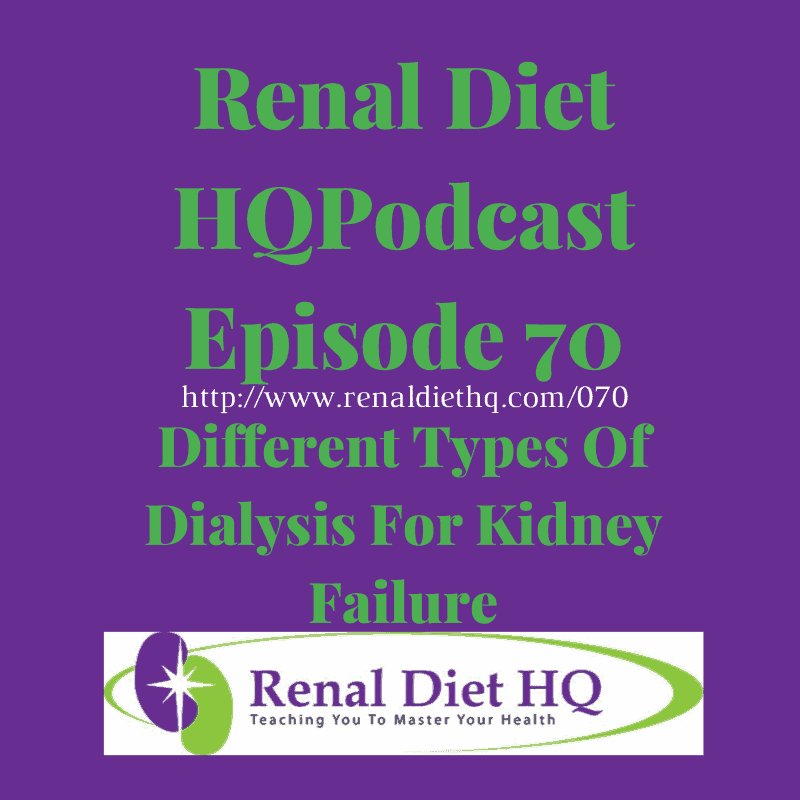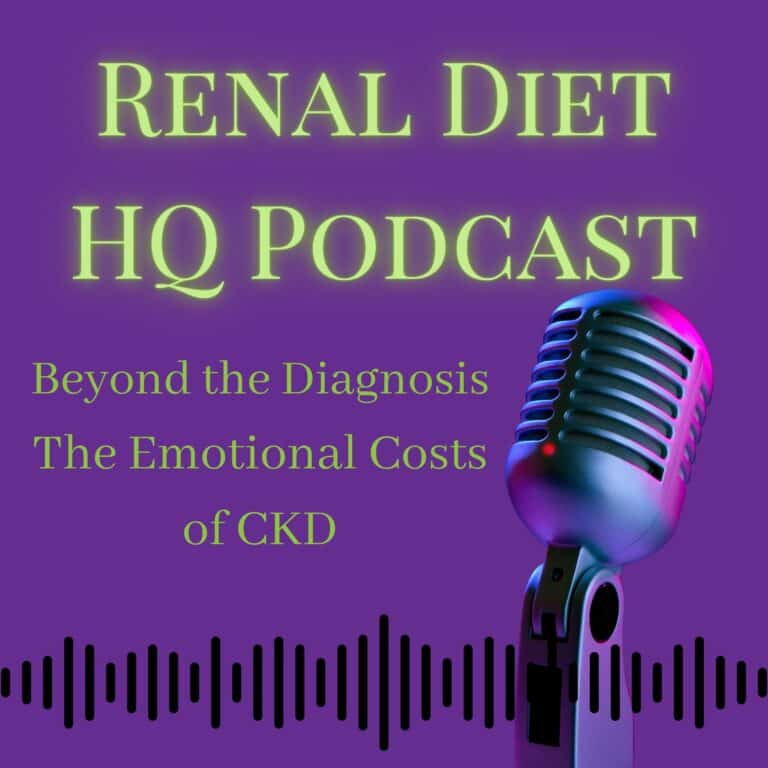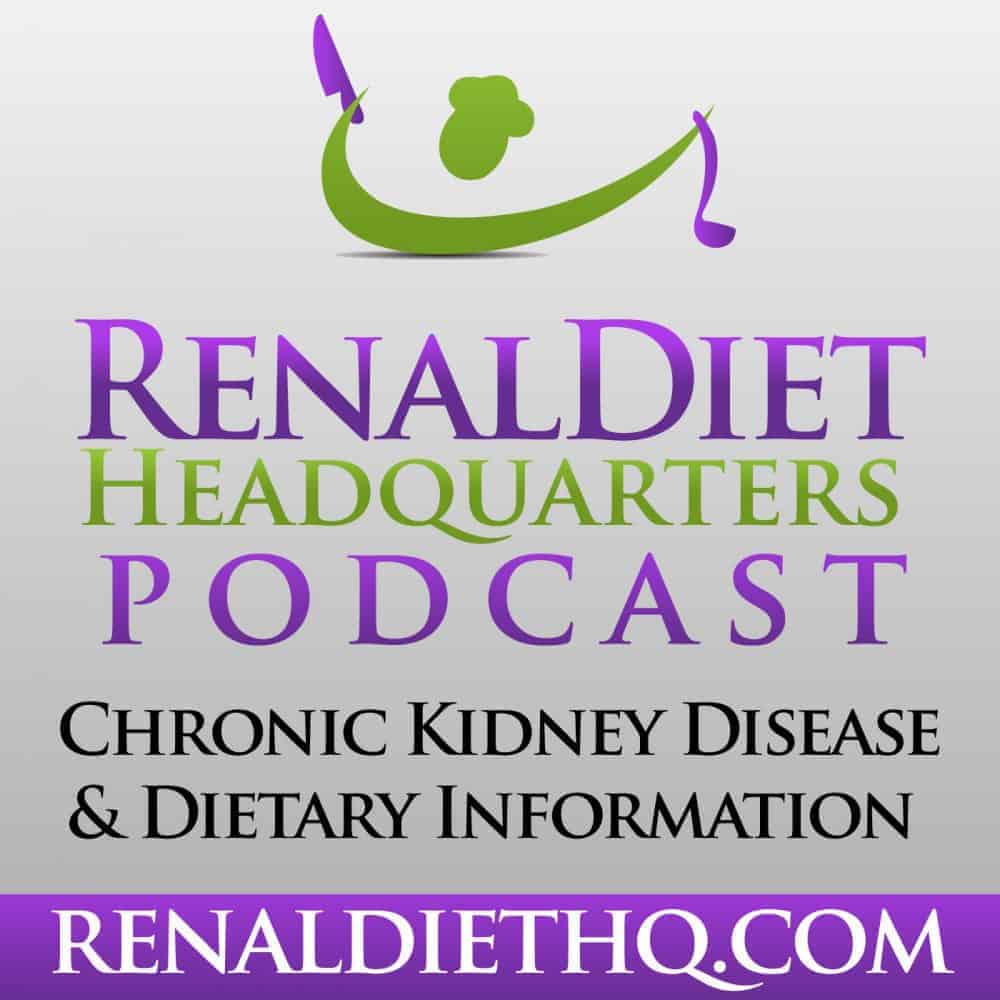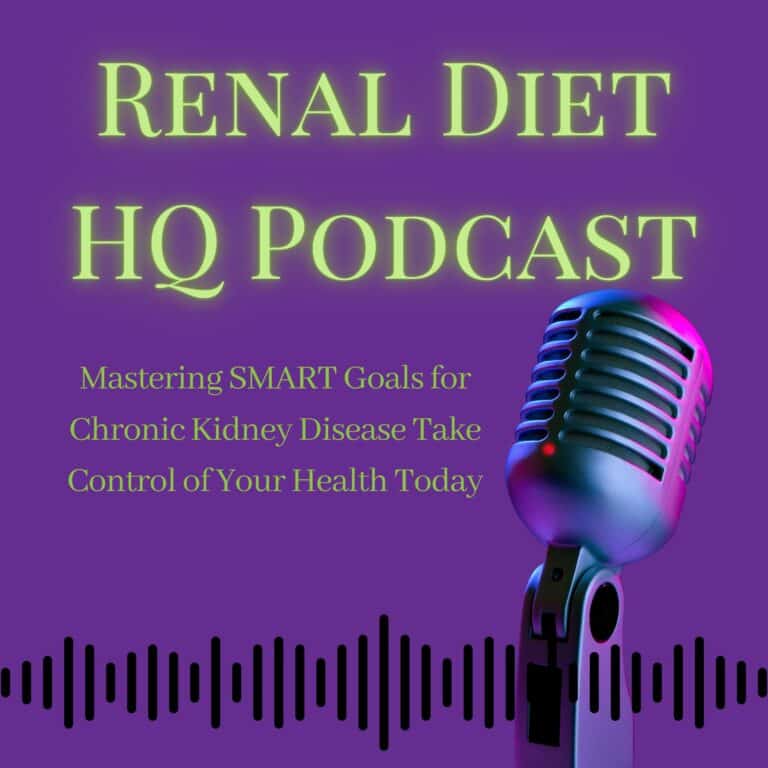Renal Diet Podcast 070 - Different Types of Dialysis
Podcast: Play in new window | Download
 Different Types of Dialysis for Kidney Failure
Different Types of Dialysis for Kidney Failure
Podcast #70 Released on January 23, 2018
Dialysis happens when you get to end-stage renal disease and you're stage 5 and your kidneys are down to 10% or 5% function.
Prior to that time while you're still kind of feeling decent but you know that this day is coming. You've talked to your doctor about it, you've reviewed your options. Maybe you're not eligible for a transplant or you just haven't found a donor yet so you decide to do dialysis because you want to continue to have your life and you get a fistula placed which is a spot in one of your veins or you get a tube in your stomach placed depending on which type of dialysis that you're going to do.
The dialysis is going to be either peritoneal or hemodialysis. Peritoneal goes into your stomach while hemodialysis is your blood.
The hemodialysis is the most common and you'd get a fistula placed and what that is it's kind of a place where they bring your artery in your vein together, they connect it, takes a little while to heal but once it heals then your body is able to use that to put the needles in. It involves needles, it involves filters, it involves machines. So, once then you get to the point where that's healed and the reason why you do that a little bit early is because in dialysis, you don't always choose when it starts so being ready for it is a good thing. Having the dialysis fistula put in or the connector for the peritoneal and then you get ready.
The 3 different ways that you can do dialysis. You can do hemodialysis two ways. You can either get it done in the center which means you go to a facility, a nurse hooks you up, you lay there for 3 hours or 4 hours while they clean and filter your blood. You do that three times a week, you have a fairly restrictive diet. You are restricted on your fluids because at this point, your kidneys aren't working at all or very little and so you are not able to get rid of any fluid between dialysis treatments.
Therefore, you have to limit what fluid you take in so that's where fluid restrictions happen. You get your restrictive diet because your body holds on to all that potassium and phosphorus and your blood is only cleaned every two days whereas with your kidneys, your blood is being cleaned constantly.
You have another option within center dialysis. Sometimes you have the option to have an overnight stay so that would be a gentler dialysis. The three-hour one is pretty fast and it can leave you feeling really tired because you just did two days worth of filtering of your blood in three hours. You can do overnight so they can hook you up and they do it maybe over a period of eight hours. Some places have this, some places don't.
You also have with hemodialysis, the option for home dialysis so you can have a machine at your house or a machine that you can take with you. You have to have different chemicals; you get trained over time so a lot of times you'll start with an in center dialysis and then you'll go to in-center and then you'll switch and they'll train you for several weeks and you'll learn how to put in your own needles or have someone help you with the needles, you'll have help at home but you'll basically be able to do dialysis every day so you're cleaning your blood more often. Your diet is a lot less restrictive and you're able to have more freedom because you could go places and not have to worry about finding a center where you're going. So, if you go on vacation, you can take your machine with you.
In-home dialysis is the most flexible diet and the easiest to do because you do that for 2 or 3 hours a day, you can do it overnight that type of thing.
The 3rd one is called peritoneal dialysis. Peritoneal dialysis is a process where you take in your stomach area. You have a lining that goes between your skin and your intestines and it's called the Peritoneum.
What happens is they put a catheter into that area and then they fill it with the dialysate which is the fluid that removes the potassium, phosphorus, urea all that waste that's in your blood and so it's kind of like osmosis and it goes through the lining. The concentration is higher in the dialysate so it pulls those things out of your blood and then you do what are called the exchanges where you trade out that fluid 2, 3, 4, 5, 6 times a day. You're sometimes able to do it overnight so you basically walk around and do your regular activities but you a fluid in your stomach constantly that can add 4 or 5 pounds to your body but it's doing the dialysis. It is like a constant dialysis and it works like your kidneys. Those are convenient and easy to do and doing exchanges, it does not involve needles so a lot of people like that a lot better.
You just have to decide what is the best for you and what is your kind of body going to deal with the best. For a lot of people in center dialysis is nice because they just lay there for three hours and while it happens and they just have to go three times a week.
The limitations on the diet are the worst but then peritoneal and home hemo involve you doing some activities and you being responsible for some of that but in exchange you get a lot of freedom as far as time and flexibility and not having to drive to a center or that type of thing.
It's up for you to decide but I want you to be aware that there's more than just what you may have seen on television or read or driven by the centers to see that there's more than that available and those are all things that you can do and that your insurance will pay for.
Send in your questions about all things related to Chronic Kidney Disease to [email protected]
Don't forget to check out my blog.
Email me at [email protected] for suggestions
Learn more About Renal Diet Podcast 069 - My Philosophy on Kidney Disease Diet
Learn more About Renal Diet Podcast 071 - Eating Whole Wheat Bread
Find us on iTunes at: www.renaldiethq.com/itunes
Find us on stitcher radio at: www.renaldiethq.com/go/stitcher
[socialshare style="hc" title="Share This Page" facebook="yes" twitter="yes" googleplus="yes" color="FAFAFA" bcolor="DDDDDD"]







